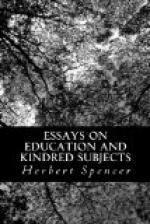The bodily indications of painful emotions are equally numerous, and still more vehement. Discontent is shown by raised eyebrows and wrinkled forehead; disgust by a curl of the lip; offence by a pout. The impatient man beats a tattoo with his fingers on the table, swings his pendent leg with increasing rapidity, gives needless pokings to the fire, and presently paces with hasty strides about the room. In great grief there is wringing of the hands, and even tearing of the hair. An angry child stamps, or rolls on its back and kicks its heels in the air; and in manhood, anger, first showing itself in frowns, in distended nostrils, in compressed lips, goes on to produce grinding of the teeth, clenching of the fingers, blows of the fist on the table, and perhaps ends in a violent attack on the offending person, or in throwing about and breaking the furniture. From that pursing of the mouth indicative of slight displeasure, up to the frantic struggles of the maniac, we shall find that mental irritation tends to vent itself in bodily activity.
All feelings, then—sensations or emotions, pleasurable or painful—have this common characteristic, that they are muscular stimuli. Not forgetting the few apparently exceptional cases in which emotions exceeding a certain intensity produce prostration, we may set it down as a general law that, alike in man and animals, there is a direct connection between feeling and motion; the last growing more vehement as the first grows more intense. Were it allowable here to treat the matter scientifically, we might trace this general law down to the principle known among physiologists as that of reflex action.[2] Without doing this, however, the above numerous instances justify the generalisation, that mental excitement of all kinds ends in excitement of the muscles; and that the two preserve a more or less constant ratio to each other.
* * * * *
“But what has all this to do with The Origin and Function of Music?” asks the reader. Very much, as we shall presently see. All music is originally vocal. All vocal sounds are produced by the agency of certain muscles. These muscles, in common with those of the body at large, are excited to contraction by pleasurable and painful feelings. And therefore it is that feelings demonstrate themselves in sounds as well as in movements. Therefore it is that Carlo barks as well as leaps when he is let out—that puss purrs as well as erects her tail—that the canary chirps as well as flutters. Therefore it is that the angry lion roars while he lashes his sides, and the dog growls while he retracts his lip. Therefore it is that the maimed animal not only struggles, but howls. And it is from this cause that in human beings bodily suffering expresses itself not only in contortions, but in shrieks and groans—that in anger, and fear, and grief, the gesticulations are accompanied by shouts and screams—that delightful sensations are followed by exclamations—and that we hear screams of joy and shouts of exultation.




